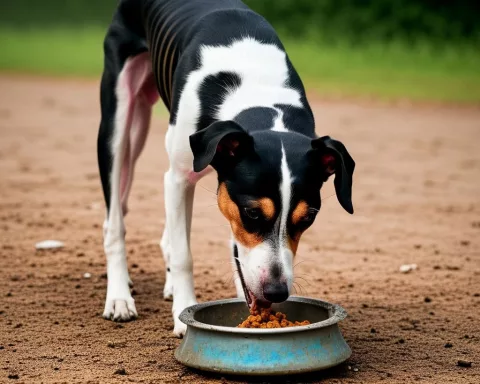Animal welfare society (AWS) has been flooded with distress calls following a recent spate of severe thunderstorms that have affected domestic and stray animals. The loud noise and intense light cause confusion among animals, leading many to bolt from their homes and become vulnerable to harsh weather conditions and oncoming vehicles. AWS staff have been witness to heartbreaking incidents of animal suffering, resulting in an increased workload and limited resources for the society. It is crucial for pet owners to take responsibility for their pet’s safety and comfort during harsh weather conditions.
Rising Alarms: Animal Distress Following Thunderstorms
Severe thunderstorms have a devastating effect on animals. The loud noise and intense light cause fear and confusion among the animals, leading to many of them bolting from their homes. The harsh weather conditions such as the biting cold claim the lives of many animals, and fleeing from the weather puts the animals in the path of oncoming vehicles. Animal Welfare Society (AWS) found themselves swamped with distress calls during the recent spate of severe thunderstorms. It is imperative for pet owners to assume responsibility for their pet’s safety and comfort in such harsh weather conditions.
Rising Alarms: Animal Distress Following Thunderstorms
The recent spate of severe thunderstorms that lashed the city also brought about a less noticed tragedy – the effects of the harsh weather on our domestic pets and stray animals. As the storms raged, the local Animal Welfare Society (AWS) found itself swamped with a barrage of distress calls, laying bare a sombre reality of the pain and suffering endured by these creatures.
The storms, characterized by their thunderous noise and intense light, wrought fear and confusion among the animals, resulting in many of them bolting from their homes. Sadly, the unforgiving outdoors provided no respite. The biting cold was merciless, claiming lives such as a forsaken kitten from Rylands Estate who fell victim to the frosty weather.
Fleeing from the weather, many animals ended up on busy thoroughfares, setting the stage for a chain of horrific accidents. Far from finding a safe haven, these animals found themselves in the path of oncoming vehicles, left to endure unbearable pain before their eventual demise.
Heartbreaking Accounts: AWS’ Gruesome Discoveries
The committed staff from the AWS’ Inspectorate and Hospital were witnesses to several heartbreaking occurrences over the weekend. Amongst these was a dog, discovered immobile on a street, with a fractured spine. In a humane act, they were forced to put her to sleep to relieve her of her suffering. A similar unfortunate incident befell a cat, also hit by a vehicle, with a comparable injury.
A particularly distressing sight met the team a few hundred meters from the hospital entrance. An abandoned dog, tethered to a pole, had weathered the harsh cold with severe wounds and infested injuries. Despite their best attempts to save him, the AWS team found themselves in the difficult position of having to euthanise him.
Mounting Burdens: Increased Workload And Limited Resources
These increasing incidents of animal distress have significantly piled up the workload for the AWS, known to be the sole animal welfare hospital in the entire Cape Metro that remains open on Sundays and public holidays. Allan Perrins, the spokesperson for AWS SA, explained this as a situation they have been adjusting to since the commencement of 2024.
Perrins is also encouraging pet owners to assume responsibility for the welfare of their pets and adopt sufficient measures to secure their pets’ safety and comfort. This proactive stance is vital, especially in the light of the persisting harsh weather conditions that seem relentless.
While AWS remains committed to providing assistance to animals in distress, the society’s resources are severely strained. They are heavily dependent on the public’s support and urge them to promptly report any incidents of animals in trouble.
A Call To Action: Ensuring Animal Safety And Welfare
The aftermath of the thunderstorms brings to light a chilling narrative of animal suffering, a stark reminder of our shared obligation towards these helpless creatures. It serves as an urgent appeal for us to not only respond to their distress but also aim to prevent it, if possible. As we navigate these storms, it is imperative to ensure that the animals within our community do not disproportionately suffer due to nature’s fury.
Despite the bleak scenario, there is some solace in knowing that organizations like AWS persist in their relentless efforts, drawing attention to the often ignored struggle of animals and providing them with the care and compassion they so rightly deserve. The fight against nature’s wrath and human neglect is far from over, but with ongoing efforts from empathetic citizens and dedicated organizations, we can aspire for a safer, comfortable world for our animal friends.
What is the impact of severe thunderstorms on animals?
Severe thunderstorms have a devastating effect on animals, causing fear and confusion among them. The harsh weather conditions, such as the biting cold, put animals in danger of becoming vulnerable to oncoming vehicles and even losing their lives.
What has been the Animal Welfare Society’s (AWS) experience during the recent spate of severe thunderstorms?
The AWS has been flooded with distress calls during the recent spate of severe thunderstorms, with many domestic and stray animals suffering from the harsh weather conditions. The AWS staff have been witness to heartbreaking incidents of animal suffering, resulting in an increased workload and limited resources for the society.
What should pet owners do during harsh weather conditions?
Pet owners must take responsibility for their pet’s safety and comfort during harsh weather conditions. They must adopt sufficient measures to secure their pets’ safety and ensure their well-being.
How has the AWS been affected by the increasing incidents of animal distress?
The increasing incidents of animal distress have significantly piled up the workload for the AWS. The society’s resources are severely strained, and they are heavily dependent on the public’s support to report any incidents of animals in trouble.
What can we do to ensure animal safety and welfare during and after severe weather conditions?
We must respond promptly to their distress and aim to prevent it if possible. It is crucial to ensure that animals within our community do not disproportionately suffer due to nature’s fury. Organizations like AWS persist in their relentless efforts, drawing attention to the often-ignored struggle of animals and providing them with the care and compassion they so rightly deserve.
How can we support the AWS in their efforts to help animals in distress?
We can support the AWS by reporting any incidents of animals in trouble promptly. The society’s resources are severely strained, and they are heavily dependent on public support to continue their efforts.












